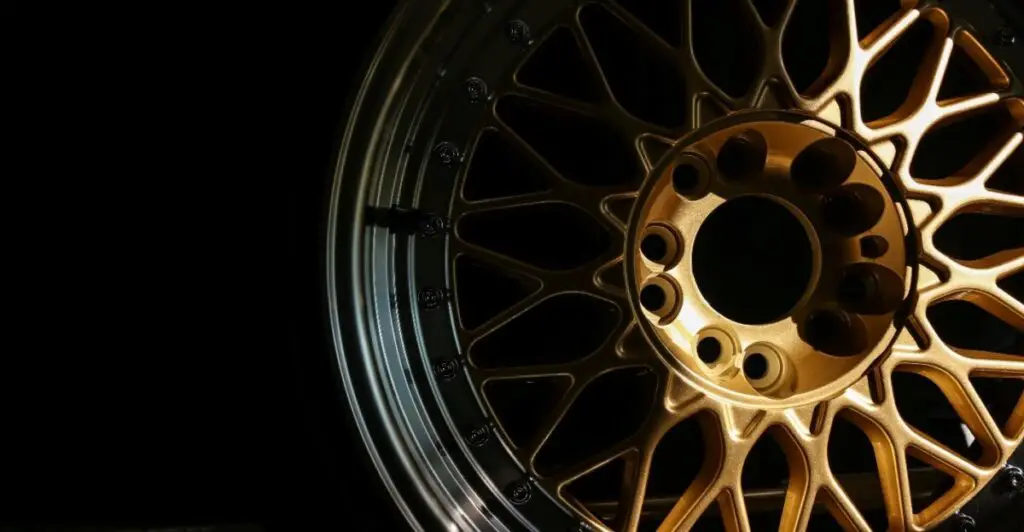|
Getting your Trinity Audio player ready...
|
A seemingly simple invention, the wheel has revolutionised the course of human history. But when was the wheel first invented?
From mysterious origins through its evolution, the wheel paved the way for advancements in transportation, trade, and technology. Have you ever stopped to consider the incredible impact the amazing circular device has had on the world?
Since the wheel was invented over 5,500 years ago, it has changed the world in a multitude of ways, transforming civilisations and technology. It has powered everything from the first ever wooden fixed-wheel carts to the cutting-edge AI-driven vehicles of the 21st century and everything in between.
Join us as we explore the story of the wheel and how it changed the course of civilisation.
Photo: Giorgio Trovato/Unsplash. Modern wheel
When was the Wheel First Invented and its Origins

We’ve all heard the expression, The best invention since the wheel. Unlike inventions inspired by the natural world, such as solar cells, turbines, and glues, the wheel is the result of brain power.
So, how was the first ever wheel invented and when?
Theories on how the wheel was invented.
When the first ever wheel was seen, man had invented the sailboat, tools made from metal alloys, musical instruments, woven cloth and pottery.
The wheel and axel concept meant the axles had to lodge in the centre of the wheel firmly but not tightly. To make the wheel rotate freely presented problems. This was probably why it wasn’t invented until the Bronze Age, as metal tools were essential for the fine chiseling required for the holes.
The origins of the wheel are unclear and there are several theories about its invention. However, evidence suggests that it was developed independently in different parts of the world. And it was based on the wheels used for tasks such as pottery, weaving, and spinning. Other theories propose that it was a natural development of the waterwheel used for irrigation, wheels used for milling. Or simply inspired by rolling logs to move heavy objects.
Regardless of its origins, the wheel likely resulted from a gradual process of experimentation and improvement over time. And it may not have been a single invention by an individual.
Examples of the earliest use of the wheel
While the wheel is mostly associated with vehicles, it was used in a variety of other contexts in ancient times. Here are some examples of the earliest uses of the wheel:
Pottery
The potter’s wheel used to shape clay into pottery, is believed to have been invented in Mesopotamia around 4500 BC.
Milling
The earliest known use of the wheel for grinding grain or other things was around 3500 BC. Then stone grinding wheels were used in Mesopotamia.
Irrigation
The earliest known water wheels used to power irrigation systems were first developed in Greece and Rome around 200BC.
Textiles
The spinning wheel, which was used to spin thread and yarn for weaving into textiles is believed to have been invented in India or the Middle East around 500 BC.
The first known wheeled vehicles.

The earliest depictions we have of a wheeled vehicle is from the Bronocice pot found in Poland in 1976. It has been radiocarbon dated to 3500-3350 BC and the carved images seem to represent a cart with four wheels. If the pictographs are of wheeled carts, this could be evidence that wheels were invented in Central Europe as early as the 4th millennium BC.
Other evidence of the first ever wheel is around the same time from archaeological findings in ancient Mesopotamia (present-day Iraq). There wheeled carts were depicted in pottery dating back to 3,500 BC. The carts pulled by oxen or donkeys, were likely used for a variety of purposes. Transporting goods and people, ploughing fields, and carrying building materials, among them.
There is also evidence of wheeled vehicles in other ancient civilisations. The Indus Valley Civilisation in present-day India and Pakistan, as well as ancient China are two.
Wheeled toys have been discovered in Pre-Columbia America that are at least 3,500 years old. But the wheel wasn’t used on a practical level. This could be due to the lack of large beasts capable of pulling heavy carts and wagons.
The Evolution of the Wheel
The earliest wheels were simple solid disks made of wood or stone and used primarily for pottery, grinding, and other tasks. Over time, the design of the wheel evolved as it was used for transportation. Later, the inclusion of spokes made the wheel lighter, and a metal rim made the wheel more durable.
In 2002, the oldest wooden wheel ever unearthed was discovered in The Ljubljana Marshes, in Slovenia. This is evidence that wooden wheels appeared almost simultaneously in Mesopotamia and Europe. The wheel was part of a two-wheeled pushcart made of ash wood, found along with a 124-centimetre-long (48+7⁄8 in) oak axle. It was radiocarbon dated as approximately 5,150 years old.
The development of the wheel from ancient times to present day
The development of the wheel has experienced significant changes from ancient times to the present day. Once the wheel and axle had been mastered, it wasn’t long before improvements were made to make it lighter, faster and more durable.
Spoked wheels
The spoke wheel was one of the earliest improvements. Evidence of horse-drawn chariots with spoke wheels appeared around 4,000 years ago in Asia Minor. In 1802, G.F. Bauer patented the first wire tension spoke that eventually evolved into the round wire tension spokes used for bicycles.
Bushing bearings
The use of bearings was a significant development, with early wood and bone bearings plus other materials. Metal bearings were later developed, providing greater durability and strength. The bush bearing, probably invented by the Romans, helped the wheel rotate more smoothly around the axle. The use of lubrication, such as animal fat or vegetable oil, also helped to reduce friction and improve the performance of the wheel.
Iron rims
Celtic chariots around 1000BC added iron to the rim or outer edge of the wheel, to increase strength and durability. With the growing network of paved roads, the wear and tear on wooden rims would have made this an essential component.
Flywheels and the steam engine
Flywheels were used to store energy in a steam engine when it produced power. And they released it when it was not producing power to maintain a steady rotation. They were important to the smooth and efficient operation of engines and machines in the 18th and 19th centuries. They were commonly found in factories, traction engines, and other large industrial machines.
Pneumatic tyres
In 1845, R.W.Thompson patented the first pneumatic (compressed air) tyre to improve the efficiency of horse-drawn carriages. John Boyd Dunlop patented a similar pneumatic tyre with the aim of improving bicycle wheels. His design was used in the emerging motor car industry of the 1890s.
Alloy wheels
The 20th century brought new designs of wheels and tyres. They were optimised for different types of vehicles and terrains, driven by the development of the automobile and aviation industries.
There are two main types of wheels used in automobiles today – steel and alloy. Alloy wheels are made using light metals like aluminum and nickel, making them better for automotive purposes.
The use of the wheel in transportation and trade
The wheel has played a critical role in transportation and trade throughout history, allowing goods to be transported more efficiently over long distances. This brought significant changes to societies.

Transporting goods over longer distances more easily, gave people access to more markets. Communities expanded when there was no need to live close to production areas to ensure a steady supply of food. Furthermore, farmers were not limited to local markets and could travel with their goods to sell them in other areas.
With the exchange of goods came the exchange of ideas. And that brought people from different regions into contact with each other and creating a more interconnected society. This in turn led to the spread of culture, development of trade networks and the rise of urban centres. As cities grew and populations became more concentrated, the need for transportation systems increased, encouraging the development of wheeled vehicles.
In some regions of the Middle East, the wheel was abandoned for transportation and trade following the decline of the Roman Empire. The camel saddle from 500 to 100 BC made it practical to transport goods and travel long distances on camels due to the sandy terrain. However, the wheel continued to be used for tasks such as irrigation, milling, and pottery in Middle Eastern societies.
The impact of the wheel on commerce and industry
The development of the wheel has had a profound impact on commerce and industry from its earliest beginnings. Here are a few examples:
Improved transportation
The wheel allowed easier transportation of goods over long distances, creating new trade routes and the development of trade networks, increased economic activity, and the rise of urban centres.
Increased productivity
The use of wheeled vehicles led to the more efficient transportation of goods enabling businesses to produce more goods and sell them at a lower cost, ultimately benefiting consumers.
Specialisation
With the ability to transport goods over longer distances and more easily, people had greater access to a wider market.
Innovation
The development of wheeled vehicles has led to new innovations in technology and engineering. As people sought to improve the efficiency and reliability of the wheel and axle system, they created new materials, manufacturing techniques, and designs. This initiated advancements in other areas, such as metallurgy and woodworking.
Some examples of important wheel-based innovations that have changed the word include:
Waterwheels
- a mechanical device that uses the energy of flowing water to rotate a wheel or turbine which can be used to power other machines.
Flywheels
- a heavy, rotating disc or wheel used to store and maintain the rotational energy of a machine or system.
Pulleys
- a simple machine that consists of a grooved wheel and a rope, cable, or belt that runs around it, used to lift, or move heavy objects.
Rotating gears
- mechanical components that consist of toothed wheels that mesh, used to transmit torque and power between rotating shafts. They are critical components in machinery such as engines, transmissions, and gearboxes.
Steam engines

Trains, ships, rollers, and factory machines made production of goods so much faster and reliable.
The Impact of the Wheel on Society
It’s nearly impossible to fathom a world without the wheel. The wheel’s impact on society and its influence in shaping civilisations is greater than any other single invention in history. It has galvanised transportation, commerce, manufacturing, agriculture, and infrastructure, and defined the way we live, work, and travel.
The role of the wheel in shaping civilisations
Without the invention of the wheel, the civilisations of Mesopotamia, Egypt, and China would not have been able to expand as far and as quickly as they did, and there would have been no Roman Empire, Renaissance, or Industrial Revolution. Trade networks and communication between different regions would have been severely limited, slowing the exchange of ideas, goods, and resources. There would be none of the technological inventions we take for granted today.
The Future of the Wheel
Can we reinvent the wheel?
Advancements in wheel technology
Some modern advancements in wheel technology suggest that we can reinvent the wheel. The following are a few examples of how the world has changed and possible innovations we could see on our roads in the not-too-distant future:
The shape-shifting wheel
The shape-shifting wheel can change its shape from circular to triangular and vice versa, all while the vehicle is in motion.
Self-healing wheels
A group of researchers has developed a novel rubber material that is as tough as a traditional car tyre but also possesses self-healing properties. The self-healing capabilities would allow the tyre to mend itself while still in use, reducing the need for immediate replacement and providing additional time for repairs to be made.
The foldable wheel
The Revolve, developed by German designer Andrea Mocellin, is a versatile and space-saving solution designed for use on both bicycles and wheelchairs. The tyre can be easily and quickly folded into a compact size, roughly one-third of its original form, and securely locked in place.
The spherical AI wheel
The tyre company Goodyear revealed its proposal for an innovative, smart, and connected spherical tyre. Known as the Eagle 360 Urban, the advanced wheel concept would be the first tyre powered by artificial intelligence (AI). This futuristic design includes features that enable it to sense, decide, transform and interact.
The 3D printed airless wheel
The Michelin concept tyre, known as the ‘Tweel,‘ will incorporate 3D printing, airless construction, smart technology, rechargeability, and organic materials. The intricate design of this model, resembling the natural cellular structure of coral, would be created using bio-sourced materials. This innovative design is intended to prevent tire blowouts and would be fitted with sensors that could monitor and report its condition to the user.
Word Stock Images. Electric car.
The potential future of wheeled transportation

The potential future of wheeled transportation is a rapidly evolving and exciting subject. It is expected to be more sustainable, efficient, and safer, with a greater emphasis on innovative technology, eco-friendliness, and the use of renewable energy sources.
- Smart technology will play an important role in the safety and efficiency of wheeled transportation, such as self-driving cars as well as real-time data on tyre pressure, wear and tear.
- Airless tyre technology promises to reduce the likelihood of blowouts and the need for regular maintenance.
- With space becoming increasingly more limited, there is growing interest in foldable and collapsible vehicles that can be easily stored in small places.
- The growth of electric and hybrid vehicles will also require new wheel designs that are optimised for electric propulsion and regenerative braking.
- New modes of transportation, such as hyperloop systems and flying cars, may require entirely new wheel designs to handle the unique challenges of these modes of travel.
Final Thoughts
And so, we come to the end of our journey, tracing the history of the humble wheel. We have answered the questions – when was the wheel first invented, and how did the invention of the wheel change the world.
From its earliest beginnings to its current place in modern technology, the wheel has left an indelible mark on our world. Its impact on transportation, trade, and society has been nothing short of profound, shaping civilisations and creating new opportunities for future generations.
As we look to the future, this remarkable invention will continue to play a vital role in shaping the world.
FAQs
Q: When was the wheel first invented?
A: The exact date the wheel was invented is unknown, but there is evidence of its use as far back as 3500 BCE.
Q: How did the wheel change transportation and trade?
A: The wheel revolutionised transportation and trade through the creation of wheeled vehicles, which made it easier to transport goods and people over long distances. This greatly improved trade and commerce and helped shape civilisations.
Q: What lasting impact has the wheel had on society?
A: It revolutionised transportation and trade, created work and industries, therefore playing a major role in shaping civilisations. It is impossible to imagine the world without the wheel, as it has become vital to our existence. Its impact will be felt for generations to come.
Related Posts
Why not Join Us
If you enjoyed this article, we would like to offer you two gifts – our Starter Pack of 4 James King’s books and our Weekly Digest, which you can receive by email.

